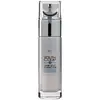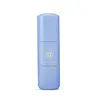What's inside
What's inside
 Key Ingredients
Key Ingredients

 Benefits
Benefits

 Concerns
Concerns

 Ingredients Side-by-side
Ingredients Side-by-side

Water
Skin ConditioningGlycerin
HumectantButylene Glycol
HumectantDimethicone
EmollientNiacinamide
SmoothingC12-15 Alkyl Benzoate
AntimicrobialAlcohol Denat.
AntimicrobialAscorbyl Glucoside
AntioxidantHydroxyethylpiperazine Ethane Sulfonic Acid
BufferingC13-14 Isoparaffin
EmollientPEG-100 Stearate
Stearic Acid
CleansingPotassium Hydroxide
BufferingGlyceryl Stearate
EmollientTriethanolamine
BufferingSodium Citrate
BufferingSodium Hyaluronate
HumectantPalmitic Acid
EmollientAdenosine
Skin ConditioningDisodium EDTA
Laureth-7
EmulsifyingXanthan Gum
EmulsifyingOxothiazolidinecarboxylic Acid
Skin ConditioningCastanea Sativa Seed Extract
Skin ConditioningEthylhexyl Hydroxystearate
EmollientPolyacrylamide
Cetyl Alcohol
EmollientTocopheryl Acetate
AntioxidantPhenoxyethanol
PreservativeCI 77163
Cosmetic ColorantLimonene
PerfumingParfum
MaskingWater, Glycerin, Butylene Glycol, Dimethicone, Niacinamide, C12-15 Alkyl Benzoate, Alcohol Denat., Ascorbyl Glucoside, Hydroxyethylpiperazine Ethane Sulfonic Acid, C13-14 Isoparaffin, PEG-100 Stearate, Stearic Acid, Potassium Hydroxide, Glyceryl Stearate, Triethanolamine, Sodium Citrate, Sodium Hyaluronate, Palmitic Acid, Adenosine, Disodium EDTA, Laureth-7, Xanthan Gum, Oxothiazolidinecarboxylic Acid, Castanea Sativa Seed Extract, Ethylhexyl Hydroxystearate, Polyacrylamide, Cetyl Alcohol, Tocopheryl Acetate, Phenoxyethanol, CI 77163, Limonene, Parfum
Camellia Sinensis Leaf
PerfumingGlycerin
HumectantPropanediol
SolventWater
Skin ConditioningSqualane
EmollientGlyceryl Stearate
EmollientIsononyl Isononanoate
EmollientBehenyl Alcohol
EmollientDimethicone
EmollientStearyl Alcohol
EmollientSodium Hyaluronate
HumectantHydrolyzed Collagen
EmollientHydrolyzed Elastin
EmollientBetaphycus Gelatinum Extract
BleachingCrambe Abyssinica Seed Oil
Skin ConditioningStearyl Glycyrrhetinate
Skin ConditioningAscorbyl Tetraisopalmitate
AntioxidantPhytosteryl Macadamiate
Skin ConditioningTocopheryl Acetate
AntioxidantSodium Dilauramidoglutamide Lysine
HumectantSodium Chondroitin Sulfate
Skin ConditioningPolyglyceryl-10 Eicosanedioate/Tetradecanedioate
Skin ConditioningCellulose Gum
Emulsion StabilisingHydroxyethyl Acrylate/Sodium Acryloyldimethyl Taurate Copolymer
Emulsion StabilisingDisodium Phosphate
BufferingPotassium Phosphate
BufferingDisodium EDTA
Ethylhexylglycerin
Skin ConditioningSorbitan Isostearate
EmulsifyingPolysorbate 60
EmulsifyingButylene Glycol
HumectantTocopherol
AntioxidantAlcohol
AntimicrobialParfum
MaskingPhenoxyethanol
PreservativeCamellia Sinensis Leaf, Glycerin, Propanediol, Water, Squalane, Glyceryl Stearate, Isononyl Isononanoate, Behenyl Alcohol, Dimethicone, Stearyl Alcohol, Sodium Hyaluronate, Hydrolyzed Collagen, Hydrolyzed Elastin, Betaphycus Gelatinum Extract, Crambe Abyssinica Seed Oil, Stearyl Glycyrrhetinate, Ascorbyl Tetraisopalmitate, Phytosteryl Macadamiate, Tocopheryl Acetate, Sodium Dilauramidoglutamide Lysine, Sodium Chondroitin Sulfate, Polyglyceryl-10 Eicosanedioate/Tetradecanedioate, Cellulose Gum, Hydroxyethyl Acrylate/Sodium Acryloyldimethyl Taurate Copolymer, Disodium Phosphate, Potassium Phosphate, Disodium EDTA, Ethylhexylglycerin, Sorbitan Isostearate, Polysorbate 60, Butylene Glycol, Tocopherol, Alcohol, Parfum, Phenoxyethanol
Ingredients Explained
These ingredients are found in both products.
Ingredients higher up in an ingredient list are typically present in a larger amount.
Butylene Glycol (or BG) is used within cosmetic products for a few different reasons:
Overall, Butylene Glycol is a safe and well-rounded ingredient that works well with other ingredients.
Though this ingredient works well with most skin types, some people with sensitive skin may experience a reaction such as allergic rashes, closed comedones, or itchiness.
Learn more about Butylene GlycolDimethicone is a type of synthetic silicone created from natural materials such as quartz.
What it does:
Dimethicone comes in different viscosities:
Depending on the viscosity, dimethicone has different properties.
Ingredients lists don't always show which type is used, so we recommend reaching out to the brand if you have questions about the viscosity.
This ingredient is unlikely to cause irritation because it does not get absorbed into skin. However, people with silicone allergies should be careful about using this ingredient.
Note: Dimethicone may contribute to pilling. This is because it is not oil or water soluble, so pilling may occur when layered with products. When mixed with heavy oils in a formula, the outcome is also quite greasy.
Learn more about DimethiconeDisodium EDTA plays a role in making products more stable by aiding other preservatives.
It is a chelating agent, meaning it neutralizes metal ions that may be found in a product.
Disodium EDTA is a salt of edetic acid and is found to be safe in cosmetic ingredients.
Learn more about Disodium EDTAGlycerin is already naturally found in your skin. It helps moisturize and protect your skin.
A study from 2016 found glycerin to be more effective as a humectant than AHAs and hyaluronic acid.
As a humectant, it helps the skin stay hydrated by pulling moisture to your skin. The low molecular weight of glycerin allows it to pull moisture into the deeper layers of your skin.
Hydrated skin improves your skin barrier; Your skin barrier helps protect against irritants and bacteria.
Glycerin has also been found to have antimicrobial and antiviral properties. Due to these properties, glycerin is often used in wound and burn treatments.
In cosmetics, glycerin is usually derived from plants such as soybean or palm. However, it can also be sourced from animals, such as tallow or animal fat.
This ingredient is organic, colorless, odorless, and non-toxic.
Glycerin is the name for this ingredient in American English. British English uses Glycerol/Glycerine.
Learn more about GlycerinGlyceryl Stearate is a mix of glycerin and stearic acid.
It is used to stabilize the mixing of water and oil ingredients. By preventing these ingredients from separating, it can help elongate shelf life. It can also help thicken the product's texture.
As an emollient, it helps soften skin and supports barrier-replenishing ingredients.
In cosmetics, Glyceryl Stearate is often made from vegetable oils or synthetically produced.
This ingredient may not be fungal-acne safe
Fun fact: The human body also creates Glyceryl Stearate naturally.
Learn more about Glyceryl StearateParfum is a catch-all term for an ingredient or more that is used to give a scent to products.
Also called "fragrance", this ingredient can be a blend of hundreds of chemicals or plant oils. This means every product with "fragrance" or "parfum" in the ingredients list is a different mixture.
For instance, Habanolide is a proprietary trade name for a specific aroma chemical. When used as a fragrance ingredient in cosmetics, most aroma chemicals fall under the broad labeling category of “FRAGRANCE” or “PARFUM” according to EU and US regulations.
The term 'parfum' or 'fragrance' is not regulated in many countries. In many cases, it is up to the brand to define this term.
For instance, many brands choose to label themselves as "fragrance-free" because they are not using synthetic fragrances. However, their products may still contain ingredients such as essential oils that are considered a fragrance by INCI standards.
One example is Calendula flower extract. Calendula is an essential oil that still imparts a scent or 'fragrance'.
Depending on the blend, the ingredients in the mixture can cause allergies and sensitivities on the skin. Some ingredients that are known EU allergens include linalool and citronellol.
Parfum can also be used to mask or cover an unpleasant scent.
The bottom line is: not all fragrances/parfum/ingredients are created equally. If you are worried about fragrances, we recommend taking a closer look at an ingredient. And of course, we always recommend speaking with a professional.
Learn more about ParfumPhenoxyethanol is a preservative that has germicide, antimicrobial, and aromatic properties. Studies show that phenoxyethanol can prevent microbial growth. By itself, it has a scent that is similar to that of a rose.
It's often used in formulations along with Caprylyl Glycol to preserve the shelf life of products.
Sodium Hyaluronate is hyaluronic acid's salt form. It is commonly derived from the sodium salt of hyaluronic acid.
Like hyaluronic acid, it is great at holding water and acts as a humectant. This makes it a great skin hydrating ingredient.
Sodium Hyaluronate is naturally occurring in our bodies and is mostly found in eye fluid and joints.
These are some other common types of Hyaluronic Acid:
Learn more about Sodium HyaluronateTocopheryl Acetate is AKA Vitamin E. It is an antioxidant and protects your skin from free radicals. Free radicals damage the skin by breaking down collagen.
One study found using Tocopheryl Acetate with Vitamin C decreased the number of sunburned cells.
Tocopheryl Acetate is commonly found in both skincare and dietary supplements.
Learn more about Tocopheryl AcetateWater. It's the most common cosmetic ingredient of all. You'll usually see it at the top of ingredient lists, meaning that it makes up the largest part of the product.
So why is it so popular? Water most often acts as a solvent - this means that it helps dissolve other ingredients into the formulation.
You'll also recognize water as that liquid we all need to stay alive. If you see this, drink a glass of water. Stay hydrated!
Learn more about Water